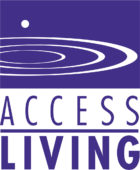Disability 101
What is disability?
The Americans with Disabilities Act (ADA) defines disability as a physical or mental impairment that substantially limits one or more major life activities. Some examples of disability may include but are not limited to:
- Physical disabilities such as amputation, deafness, or paralysis
- Neurological disabilities such as cerebral palsy or epilepsy
- Intellectual disabilities such as Downs syndrome
- Chronic illness such as Crohn’s Disease
- Mental health disabilities such as panic disorder
- Learning disabilities such as dyslexia
Disability can fall on a spectrum. Someone may have mild or moderate hearing or vision loss and not be categorized as Deaf or blind, but still have a disability. The same is true for any disability.
At what age is a disability most commonly acquired?
Disability is the only identifying characteristic that a person can acquire at any point in their life, people can be born with their disability or they can acquire it at any point in their life.
What is the Americans with Disability Act (ADA)?
The ADA is one of the most comprehensive pieces of civil rights legislation in existence. It serves to prevent the discrimination of people with disabilities in areas of life such as obtaining housing, accessing buildings, applying for jobs, and accessing education. President George H.W. Bush signed it into law in 1990.
What is an accommodation?
Accommodations are tools that enable a person to access things such as communication, technology, or have the same opportunity for success as anyone else.
Examples of accommodations include:
- Extended time on tests or assignments in school or at work
- Text-to-speech software
- Sign language interpretation
What is the Disability Rights Movement?
The Disability Rights movement started in the 1970s and continues today. It aims to push for the adoption of disability rights as civil rights and works to lessen the level of discrimination and emphasize integration.
What are disability rights?
Disability rights are civil rights. They protect people with disabilities, make it illegal to discriminate against someone on the basis of their disability.
What is disability discrimination?
Disability discrimination occurs when an individual is refused a service, access to a public space, or no longer considered for an opportunity due to their disability.
What are the different models of disability?
- Social Model – The social model of disability places emphasis on the role of society in “disabling” people as opposed to a person’s health or medical condition being the cause of their disability. This model sees disability as a thing to be celebrated and places emphasis on the need for accommodations and adaptations to be put in place so that people with disabilities can live full and integrated lives as members of the community.
- Medical Model – The medical model of disability is rooted in the idea that a person’s disability needs to be “fixed” or healed.” This model places emphasis on the role of the medical community in creating treatments, processes, or other ways to rid a person of their disability. This model shifts the narrative from one of inclusion and integration to one of repairing and innovating.
What is Independent Living Philosophy?
This philosophy says that every person, regardless of disability has the potential and the right to practice autonomy. Everyone is entitled to opportunity, respect, and access regardless of disability status.
What is organizing?
Organizing is when a person or group of people plan direct action around creating change for a specific piece of legislation or awareness around a certain viewpoint other communities may hold that positively or negatively impacts the group organizing.
What is self-advocacy?
Self-advocacy is the ability for a person to speak on behalf of their needs, ask for accommodations they might need, explain what options are available to solve access issues, and bring to attention the need for greater access as it pertains to themselves and their own functioning.
